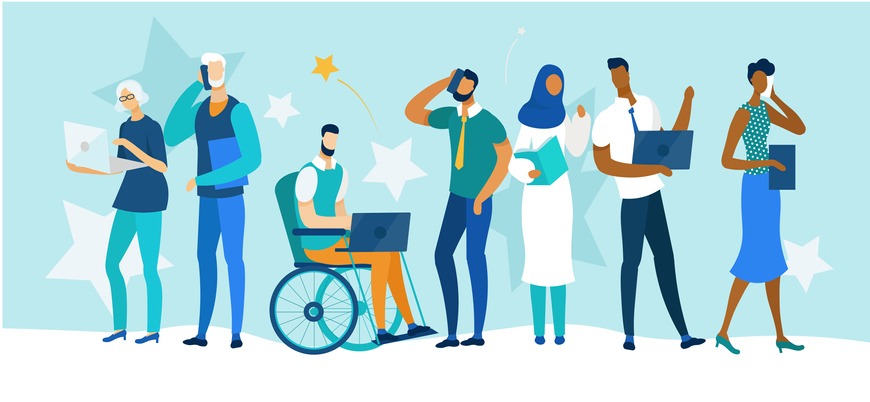
Embracing diversity and inclusivity in the modern workplace is essential for creating a high-performing workplace culture
CREDIT: This is an edited version of an article that originally appeared on Business News Daily
In the modern workplace, creating a dynamic and high-performing work culture that embraces diversity and inclusivity is crucial for your business to thrive. Today’s high-quality talent won’t tolerate toxic, myopic or unfulfilling workplace cultures. They need more than just a paycheck; they want a sense of belonging.
Consider the following best practices that diverse and inclusive companies employ to perform at the highest levels.
Establish leadership commitment to diversity and inclusivity
Establishing leadership commitment is a crucial step in creating an inclusive work culture. C-suite executives, managers and leaders must all actively demonstrate their dedication to diversity and inclusivity, serving as champions of change.
True leaders should openly support and advocate for diversity and inclusion initiatives to inspire employees at all levels to embrace these values and contribute to building a high-performing work culture.
Demonstrating a genuine belief in the value of diversity and inclusivity sets the tone for the entire organisation. This fosters an environment that values different perspectives, drives innovation and ultimately leads to success.
Create an inclusive environment
Creating an inclusive environment involves intentionally implementing the following best practices:
- Providing equal opportunities: An inclusive environment provides equal opportunities for all employees, ensuring fair access to resources and career growth.
- Implementing inclusive policies: An inclusive environment requires implementing policies promoting diversity, equity and inclusion. For example, you could incorporate diverse hiring panels and mentorship
- Fostering a sense of belonging: An inclusive environment actively fosters a sense of belonging by encouraging open dialogue, listening to diverse perspectives, and addressing bias or discrimination promptly.
- Establishing affinity groups: An inclusive environment requires establishing affinity groups to support specific communities, allowing employees to connect, share experiences and collaborate on inclusivity initiatives.
- Continuously seeking improvement: An inclusive environment requires regularly communicating, seeking employee input and addressing concerns to continuously improve and align diversity and inclusion efforts with evolving needs.
Practice diverse recruitment and hiring practices
Implementing diverse recruitment and hiring practices involves a hiring process that actively seeks and attracts candidates from a wide range of backgrounds, experiences and perspectives. This helps organisations tap into a broader talent pool and foster a more inclusive work environment.
The good news is that many companies have made significant inroads into diverse hiring practices over the last few years.
To effectively implement diverse recruitment and hiring practices, organisations should focus on the following strategies:
- Developing diverse candidate pools by exploring various recruitment sources
- Implementing bias-free hiring processes, including structured interviews and diverse interview panels
- Promoting inclusive job descriptions to attract a diverse range of candidates
- Building partnerships with diverse communities and organizations
- Providing subconscious bias training for hiring stakeholders
- Tracking diversity metrics and analysing recruitment data
Conduct ongoing diversity and inclusion training
Ongoing diversity and inclusion training promotes awareness, knowledge and skills among employees at all levels. It helps employees recognise and challenge their biases, understand different perspectives, and develop the necessary tools to create an inclusive environment.
Key aspects of ongoing diversity and inclusion training include the following:
- Building awareness: Training programs should focus on raising awareness about the importance of diversity and inclusion in the workplace.
- Unconscious bias training: Training sessions should address unconscious biases that can influence decision-making and behaviour.
- Inclusive communication and language: Teach employees to use inclusive language, avoid stereotypes, and foster respectful and inclusive conversations.
- Cross-cultural competency: Training on cross-cultural competency enhances employees’ ability to work effectively with individuals from diverse backgrounds and adapt to different communication styles and customs.
- Conflict resolution and allyship: Training should encourage allyship, teaching individuals how to be effective allies and advocates for underrepresented groups.
Foster open communication and collaboration
It’s human nature to want to be heard. When employees feel comfortable expressing their thoughts and ideas, it creates an environment where diverse perspectives can thrive. Encouraging inclusive communication and involvement – along with active listening from leaders – helps employees contribute their insights freely.
Collaboration across diverse teams is equally vital for leveraging the strengths and talents of individuals from different backgrounds. By breaking down silos and promoting cross-functional understanding, you can tap into the collective intelligence of your entire workforce.
Inclusive communication involves valuing and considering each team member’s contributions, regardless of background or position. Encouraging active participation, seeking diverse opinions and fostering an inclusive decision-making process can strengthen collaboration and generate high-quality outcomes.


Be the first to comment